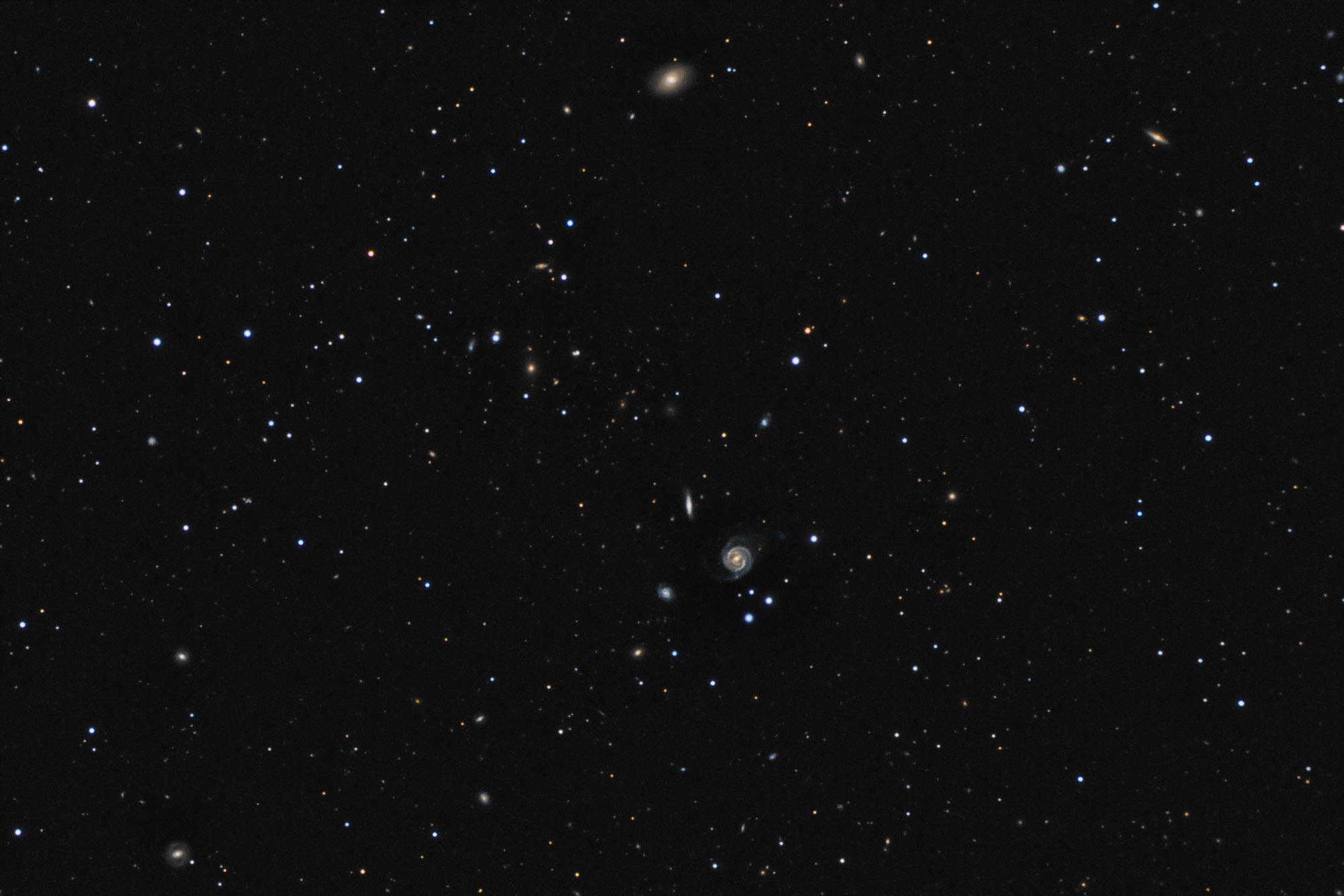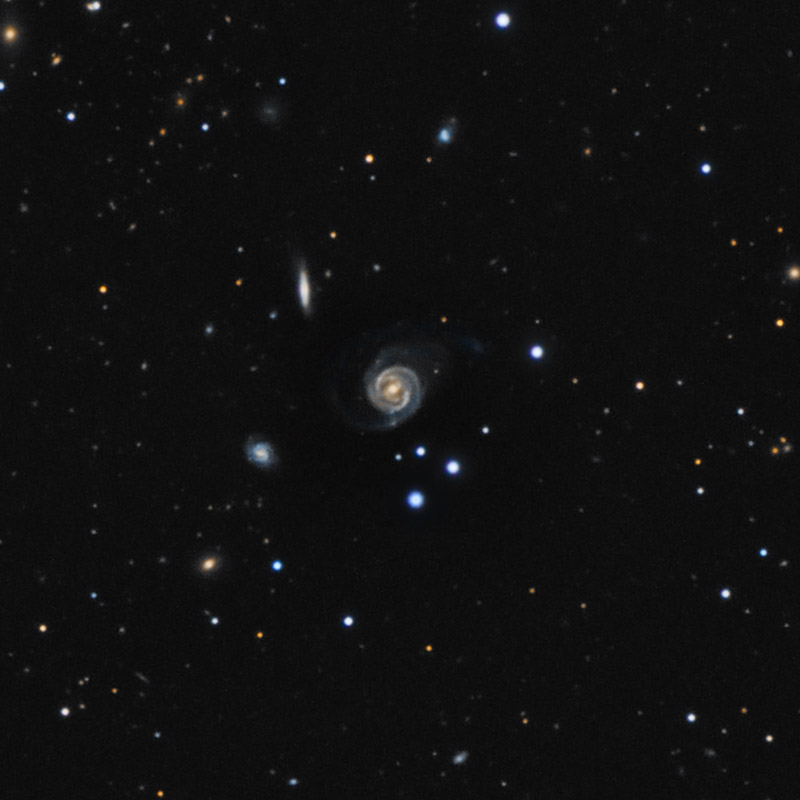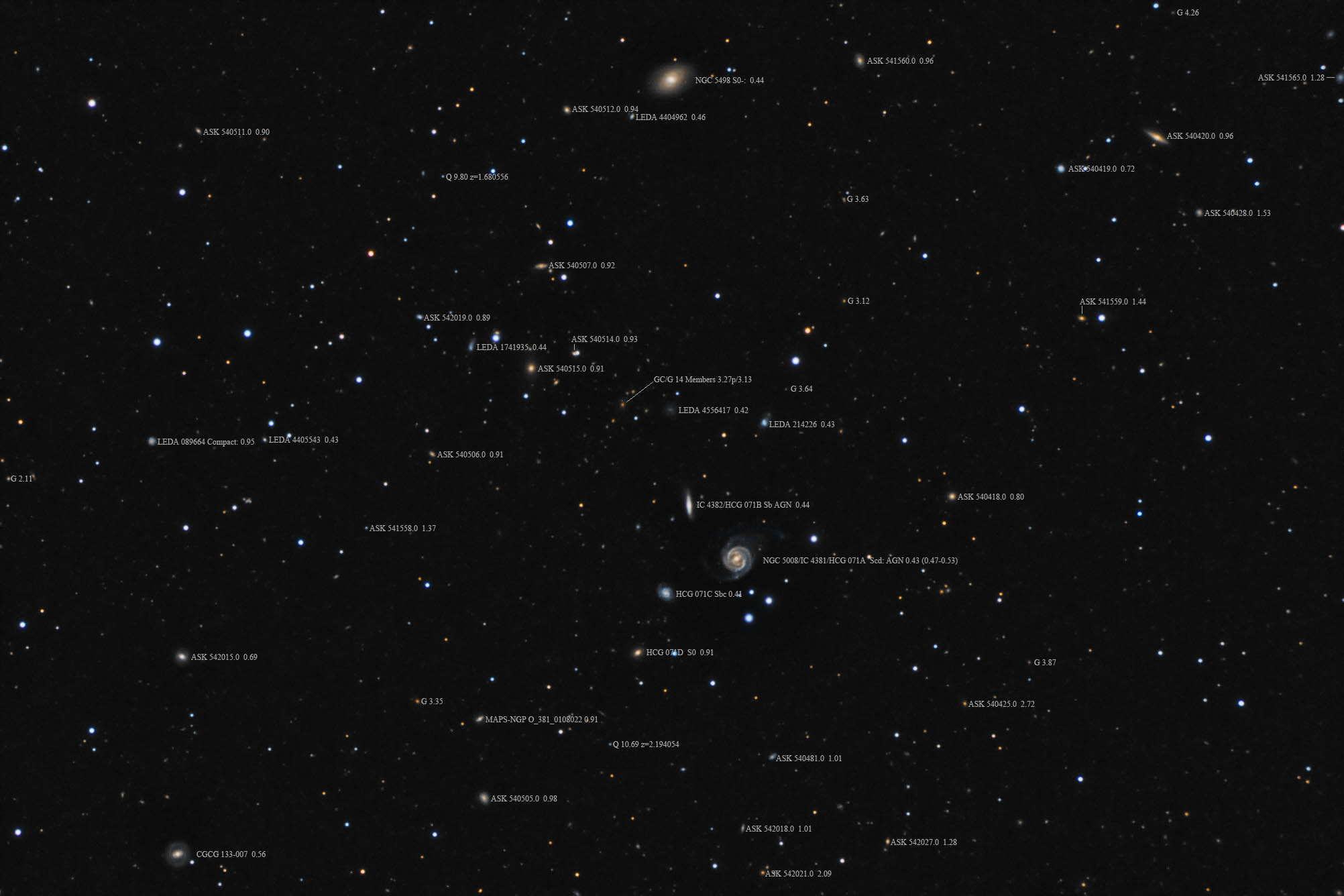Object name: HCG71Designation(s): HCG71, NGC5008, IC4382, NGC5498, This field made my to-do list for two reasons. First is the galaxy NGC 5008 which has some fascinating plumes and houses an AGN at its core. Both indicate it has recently interacted with or devoured another galaxy. Also, it is the major galaxy in the Hickson Compact Group 71. I'm slowly working on those that interest me as well. The field is located in Bootes.
NGC 5008 is classified as Scd: by NED; SBc by the NGC Project; and SBc? by Seligman. So does it have a bar or not? Maybe. I can see arguments both ways. Its arm structure is weird for either barred or not barred spirals. While there's a hint of arms starting from a very faint bar they die out quickly and spiral counterclockwise. Other arms start from nothing and go for much further and are often brighter yet spiral clockwise. They are also bluer than those coming off the possible bar. An inner counter-clockwise and outer clockwise spiral pattern with plumes would indicate some sort of merger. I find it odd no one tacked on the peculiar label. By redshift it is some 430 million light-years distant though non-redshift measurements put it slightly further.
It was discovered by Heinrich d'Arrest on May 18, 1862. But unfortunately he recorded its hour angle one hour off and noted the nearby 10th magnitude star as being north when it is south. I've greatly dimmed it in my image so it appears much dimmer but still the brightest of the three to the south as otherwise its glare was very distracting from the galaxy itself. It was then recorded as NGC 5008 at the wrong position. So when Stephane Javelle later found it on June 15, 1895 and recorded its position correctly it became IC 4381. It was only later that d'Arrest's error was discovered and the two realized to be the same galaxy. Then Hickson in recording his compact galaxy groups included it along with IC 4382 and two others (see the annotated image) as his group #71. We now know that while three of these galaxies are likely related and have similar cosmological redshifts HCG 71D has a redshift putting it twice as distant as the other three. I notice NED, while listing all four as part of the group gives the count for the group at 3, not 4. Is it excluding this more distant member?
The other four are IC 4382, HCG 71B, which also houses an AGN and is listed as an Sb edge-on spiral, PGC 50640 which is HCG 71C is listed as an Sbc spiral and the outcast PGC 50641/HCG 71D listed as an S0 galaxy at 910 million light-years. It is also the furthest from the center of the group. There appear to be other galaxies in the area that are members of the group as they too have redshifts very similar to that of NGC 5008. LEDA 214226 to the north may appear to be double in my image but the northern object is a very blue star and ultraviolet source. Then to the northeast is LEDA 1741935 which has a very off-center core making it look like a comet. It too shares about the same redshift. More ordinary looking is LEDA 4405543 to the east-northeast. It is the smallest of the group. To the north-northeast is the very low surface brightness apparently spiral LEDA 4556417. Another dwarf member of the group is LEDA 4404962 far to the north. But even further north is NGC 5498 a large S0-: galaxy that too shares the same redshift and looks possibly the most massive of the group. Others are found outside my field.
NGC 5498 was discovered by Edouard Stephan on May 9, 1882. NED lists it as S0 while the NGC Project says E-S0. It is a very large galaxy some 160,000 light-years in diameter. NGC 5008 is much larger, 280,000 light-years, if you include the plumes but the spiral itself is only 90,000 light-years in diameter. IC 4382 is actually larger at nearly 110,000 light-years but seen edge on appears much smaller. I find it odd it has no dust lane visible. It too was found by Stephane Javelle at the same time as he saw NGC 5008/IC 4381. While he made a one minute error in the position of both their relative positions match perfectly.
HCG 71C, an Sbc spiral is only about 65,000 light-years across. About the size of an average spiral. HCG 71D is about 100,000 light-years across. Only is greater distance makes it appear smaller than the other three. Of the other galaxies related to NGC 5008 and NGC 5498, LEDA 4405543 is the smallest of the group in my frame at about 23 million light-years.
While HCG 71D isn't a true member of the group it does appear to be part of a different group of galaxies seen scattered over the image. However, I found no cataloged group for either of these two other than part of the closer being part of HCG 71. Considering how many strange galaxies are in the closer group I'm surprised it hasn't received any significant attention.
14" LX200R @ f/10, L=4x10' RGB=2x10', STL-11000XM, Paramount ME Related Designation(s):2MASS J14105724+2529499, 2MASS J14110254+2531101, 2MASS J14110451+2541525, 2MASX J14105726+2529502, 2MASX J14110257+2531102, 2MASX J14110448+2541522, ASK 540478.0, ASK 540483.0, ASK 542028.0, CGCG 132-078, CGCG 132-079, CGCG 132-080, CGCG 133-001, CGCG 133-002, CGCG 133-003, CGCG 1408.7+2544, CGCG 1408.8+2545, CGCG 1408.8+2556, FIRST J141057.2+252949, FIRST J141102.5+253110, GALEXASC J141102.52+253108.5 , GALEXASC J141104.60+254152.1 , HCG 071, HCG 071A, HCG 071B, HCG71, HOLM 598A, HOLM 598B, IC 4381, IC 4382, IC4382, IRAS 14087+2545, IRAS F14087+2545, MAPS-NGP O_381_0107824, MCG +04-33-042, MCG +04-33-043, NGC 5008, NGC 5498, NGC5008, NGC5498, NSA 094791, NSA 164627, NSA 164628, NVSS J141057+252945, NVSS J141102+253106, PGC 050629, PGC 050635, PGC 050639, SDSS J141057.23+252950.0, SDSS J141057.24+252950.0, SDSS J141102.53+253109.6, SDSS J141102.54+253109.7, SDSS J141102.54+253109.8, SDSS J141104.52+254152.7, SDSS J141104.53+254152.6, SDSS J141104.53+254152.7, SPOGS 0769, SSTSL2 J141057.23+252950.1, SSTSL2 J141102.52+253110.3, UCM 1408+2543, UGC 09073, UGC 09075, USGC U600 NED01, USGC U600 NED02, USGC U600 NED03, UZC J141057.3+252951, UZC J141102.6+253110, UZC J141104.6+254153, [RPG97] 287, [TTL2012] 182290, [TTL2012] 197504, [TTL2012] 205484, | | 

